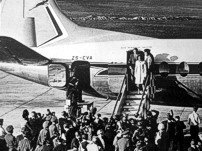
March 1962 to March 1967
South African Airways (SAA)
ZS-CVA - c/n 317 - a V.818 series Viscount
South Africa registered
March 1962
Purchased from Compañía Cubana de Aviación S.A. and named as 'Rietbok'.
18 March 1962 to 23 March 1962
Noted daily at Gatwick Airport, Surrey, England in Compania Cubana de Aviación livery with South African Airways (SAA) titles.
1 April 1962
Noted at Gatwick Airport, Surrey, England, presumably finally on its way to South Africa.

Robert 'Bobby' Kennedy and his wife arriving at Cape Town Airport, South Africa
circa May 1962
Rolled out at Jan Smuts Airport, Johannesburg, South Africa in the 'orange tail' livery'.
6 June 1966
Noted arriving at Cape Town Airport, South Africa carrying Robert 'Bobby' Francis Kennedy and his wife Ethel as part of a six day anti-apartheid tour. He delivered the annual 'Day of Affirmation' speech at the city University.
Did he know that the Viscount he had just flown on once belonged to Fidel Castro's Cubana? Exactly two years later, to the day, Bobby was assassinated during a Presidential campaign in Los Angeles, California, USA.
13 March 1967
Crashed into the Indian Ocean off Kayser Bay, 35 kms from East London, South Africa.
Flight number SA 406 from Port Elizabeth Airport, South Africa to East London Airport, South Africa was approaching East London in bad weather. At 17:09 UTC the crew reported at 2,000 feet with the coastline in sight. The aircraft crashed one minute later. All 5 crew and 20 passengers sadly died in the accident.
PROBABLE CAUSE: The available data was not sufficient for the cause of the accident to be determined with any degree of probability. In the opinion of the 'Commission of Inquiry' that was presided over by Justice Cecil Margo, certain possibilities were excluded as being consistent with the evidence and/or as being remote and improbable; among these possibilities are structural failure, failure of the controls, or control surfaces, multiple engine failure, instrument failure, explosion, fire, a 'bad weather' accident and pilot error.
However, on the evidence the 'Commission of Inquiry' could not exclude as the originating cause of the accident a heart attack suffered by the captain in the air, with ensuing loss of control of the aircraft, and with the first officer being unable in the time available to regain sufficient control to prevent contact with the sea.
2001
In his book 'Final Postponement' published in 2001, Justice Cecil Margo points to structural failure. He says that at the time of the 'Rietbok' disaster, four Viscounts had crashed. Two were found to have suffered structural failure and two had disappeared into the sea and were never located. However, he had found in the 'Rietbok' investigation that 'on the overwhelming probabilities' the aircraft was completely airworthy immediately before hitting the water.
He also says that shortly after the 'Rietbok' disaster an Aer Lingus Viscount, on a flight to Ireland, had disappeared into the sea in similar circumstances. This was followed by a crash in Australia where a Viscount disintegrated over land because the main spar had failed causing a wing to come off.
Vickers Viscount Network notes:-
Aer Lingus Viscount c/n 178 EI-AOM crashed in to the sea on 24 March 1968 while on a flight from Cork Airport, Ireland to Heathrow Airport, London, England. MMA - MacRobertson Miller Airlines Viscount c/n 45 VH-RMQ crashed at Port Hedland, Western Australia on 31 December 1968 due to metal fatigue.
Justice Cecil Margo continued 'of the four Viscounts that crashed during that period, two were found to have metal fatigue, and two disappeared into the sea, making it impossible to determine the cause of their crashes'.
South African Airways (SAA) had purchased the 'Rietbok' from Compania Cubana de Aviacion in Cuba. It had been Fidel Castro's personal aircraft. A SAA technician reported that certain mechanical work, that was supposed to have been undertaken before SAA took delivery from Vickers-Armstrongs (Aircraft) Ltd., was not done. This included replacing turbine blades that had been corroded through the use of Russian booster fuel during take-offs. These blades were later replaced in SAA's workshops.
The question must be asked why did Justice Cecil Margo in the original 'Rietbok' investigation accept that the aircraft was 'completely airworthy' and concentrated on the possibility that the pilot had suffered a heart attack or stroke?
More recently, there have been suggestions that this aircraft may have crashed due to deliberate sabotage affecting the structural strength of the aircraft. A South African Navy diver is reported to have stated that he observed that both wings were separated from the fuselage. There is mention of this in the book 'The Long Assassin' by Alan D Elsdon.
|



